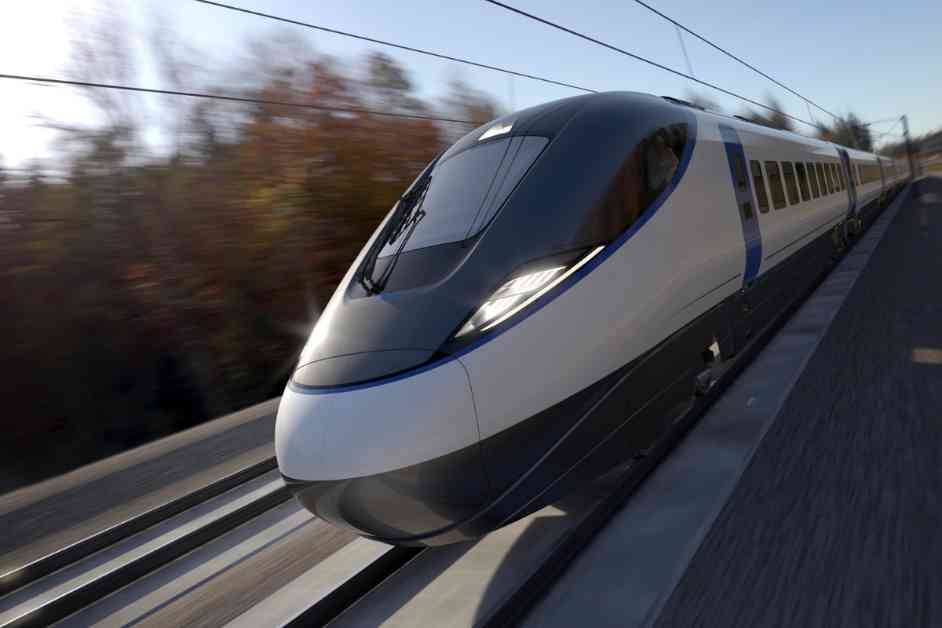A new proposal has emerged as a potential alternative to the cancelled HS2 route, offering a more affordable and efficient solution for enhancing rail connectivity between the Midlands and the north west. The concept of a new 50-mile railway line between Lichfield and High Legh has garnered attention, with a focus on maximizing capacity for both passengers and freight moving between these regions.
The Need for Enhanced Rail Connectivity
The importance of establishing a robust rail link between the Midlands and the north west cannot be understated. The existing infrastructure is strained, leading to congestion and inefficiencies that hinder economic growth and development in these areas. Recognizing these challenges, a report commissioned by the mayors of Greater Manchester and the West Midlands emphasized the critical role that improved rail connectivity plays in facilitating smoother transportation for both people and goods.
A Cost-Effective Alternative
The proposed new rail line presents a viable and cost-effective alternative to the previously cancelled HS2 extension. By connecting Lichfield to High Legh and integrating with the planned east-west Northern Powerhouse Rail, this new route offers substantial benefits at a fraction of the cost. The coalition of private sector organizations, spearheaded by former HS2 Ltd chairman Sir David Higgins, sees this as a golden opportunity to address the pressing need for enhanced connectivity between the Midlands and the north west.
In light of the escalating costs associated with the HS2 project, which led to its partial cancellation by then-Prime Minister Rishi Sunak, the new proposal offers a more financially sustainable solution. While the report did not provide a specific cost estimate for the project, it emphasized the importance of leveraging private sector financing and partnering with central and local governments to fund the remaining balance. This collaborative approach aims to optimize resources and ensure the successful realization of the new rail line.
Delivering Significant Benefits
Despite the anticipated slower speeds compared to HS2, the new rail line is projected to offer substantial benefits in terms of travel times and efficiency. Journeys between London and Manchester would only be 15 minutes longer than under the initial HS2 plans, still providing a 30-minute reduction in travel time compared to current conditions. The consortium behind the proposal estimates that the new line could deliver approximately 85% of the benefits of HS2 Phase Two at a significantly lower cost, ranging from 60 to 75% of the original budget.
One of the key factors contributing to the cost-effectiveness of the new rail line is the design approach. By utilizing tracks designed for lower speeds and incorporating simplified connections with the existing rail network, construction costs can be minimized without compromising functionality. Additionally, the use of ballasted track, which relies on a layer of crushed rock and gravel for support, offers a more economical alternative to the slab track used in the construction of HS2.
Maximizing Efficiency and Savings
The report highlights the potential for substantial cost savings by repurposing existing resources and infrastructure from the cancelled HS2 Phase Two project. By leveraging the land, powers, and design work already secured through public funds, the new rail line can be developed more efficiently and affordably. The estimated savings of £2 billion resulting from the HS2 cancellation underscore the financial advantages of pursuing this alternative approach to rail connectivity.
In addition to cost savings, the proposal emphasizes the importance of maintaining government ownership of land acquired for HS2 Phase 2a between the West Midlands and Crewe. This strategic decision ensures continuity and coherence in the development of the new rail line, enabling seamless integration with existing infrastructure and future expansion plans. Furthermore, the consortium recommends the establishment of a steering group involving the private sector, combined authorities, and the government to conduct a feasibility study and technical analysis to support the project’s implementation.
A Path Forward for Enhanced Connectivity
The unveiling of the new rail line proposal has garnered support from key stakeholders, including Greater Manchester Mayor Andy Burnham and Sir David Higgins. Emphasizing the urgency of addressing rail capacity and connectivity issues between the North and the Midlands, Burnham highlights the potential benefits of the new line in alleviating congestion and promoting economic growth. By connecting HS2 to Northern Powerhouse Rail, the proposal offers a viable alternative that delivers the majority of HS2’s benefits at a fraction of the cost.
Sir David Higgins echoes this sentiment, emphasizing the need for collaborative efforts between the government, business community, and combined authorities to move the project forward. Recognizing the challenges ahead, he underscores the importance of practical steps and concerted action to realize the vision of a new rail link between the Midlands and the north west. By demonstrating the feasibility and cost-effectiveness of the proposed alternative, the consortium aims to expedite the implementation process and deliver tangible results for improved rail connectivity.
In conclusion, the unveiling of the new affordable rail line plan represents a significant milestone in addressing the pressing need for enhanced connectivity between the Midlands and the north west. By offering a cost-effective alternative to the cancelled HS2 route, the proposal presents a viable solution that maximizes benefits while minimizing financial burdens. With support from key stakeholders and a strategic roadmap for implementation, the new rail line has the potential to revolutionize transportation in the region and pave the way for sustained economic growth and development.




















